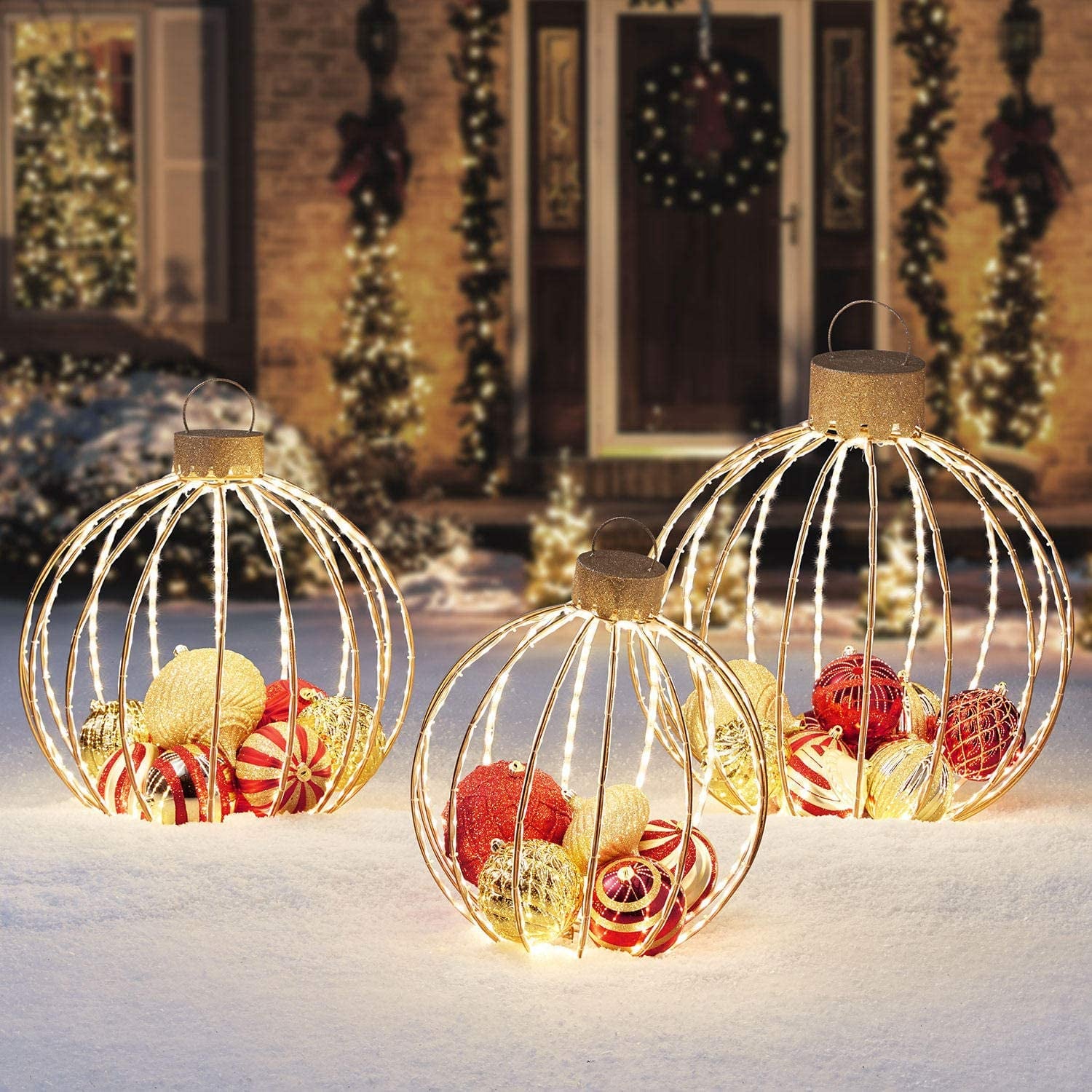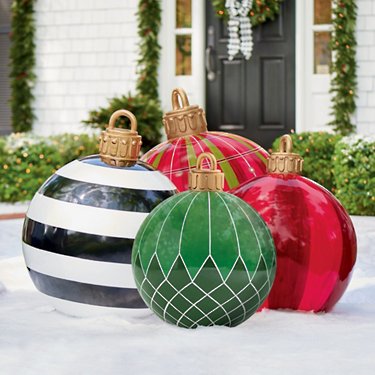
The allure of the great outdoors has perpetually fascinated individuals, beckoning them to infuse personal touches and embellishments into the natural canvas. Among the various ways to enhance outdoor spaces, the art of outdoor ornamentation stands out as an intricate yet profoundly rewarding endeavor. From traditional garden statues and sculptures to modern artistic installations, outdoor ornamentation encompasses a wide array of decorative elements that elevate the aesthetic appeal of gardens, parks, and various open spaces.
Outdoor ornaments encompass a diverse array of decorative elements designed to enhance the aesthetic appeal of outdoor spaces. From classical statues and sculptures to modern fountains and garden ornaments, these embellishments add character and charm to gardens, parks, and various open areas. Crafted from materials like stone, metal, wood, and resin, these ornaments come in various forms, contributing to the visual allure of landscapes. Whether through elegant sculptures or functional garden ornaments, outdoor ornamentation allows individuals to infuse their personal touch into nature, creating captivating and inviting outdoor environments.
Historical Evolution of Outdoor Ornamentation
Outdoor ornamentation is not a novel concept. Throughout history, civilizations across the globe have used outdoor ornaments to signify cultural, religious, and artistic expressions. Ancient Egyptian gardens featured sculptures of deities and pharaohs, while Greco-Roman gardens were adorned with statues of gods and heroes. The European Renaissance period witnessed a resurgence of interest in outdoor ornamentation, with intricate fountains, sculptures, and topiary becoming prominent features in grand estates and gardens.
Types of Outdoor Ornaments
1. Statues and Sculptures: Statues and sculptures are quintessential outdoor ornaments. These can range from classical replicas of famous figures to abstract, modern pieces. They add a sense of character and charm to gardens and outdoor spaces, becoming focal points or subtly blending into the surroundings, depending on the design and placement.
2. Fountains and Water Features: Water elements, such as fountains, ponds, and waterfalls, not only bring a sense of tranquility but also add an element of movement and sound to outdoor spaces. They can be elaborate, like tiered fountains in formal gardens, or minimalist, with simple, contemporary designs.
3. Garden Ornaments: These include sundials, bird baths, garden gnomes, and other decorative elements that contribute to the visual appeal of the garden. These smaller ornaments often hold symbolic or practical significance, such as attracting birds or marking time.
4. Architectural Elements: Gazebos, arbors, pergolas, and trellises are architectural features that complement outdoor ornamentation. They provide structure, height, and can serve as supports for climbing plants, further enhancing the overall aesthetic.

Materials and Design
Outdoor ornaments are crafted from various materials, including stone, metal, wood, and resin. Stone sculptures and ornaments offer durability and a classic aesthetic, while metal sculptures provide a modern and versatile design. Wood offers a more rustic appeal and is often used for decorative furniture and birdhouses. The choice of material often depends on the intended style, environment, and maintenance considerations.
Design aspects are crucial. Ornamental elements should complement the landscape, considering factors like scale, proportion, and color schemes to ensure harmony with the surroundings.
Benefits of Outdoor Ornamentation
a. Enhanced Aesthetics: Outdoor ornaments transform plain landscapes into captivating, visually appealing spaces. They add depth, character, and a unique touch, contributing to the overall ambiance.
b. Emotional Well-being: Outdoor ornamentation, particularly in natural settings, can have a profound impact on mental health. The beauty and serenity of adorned spaces provide a sense of tranquility and relaxation.
c. Cultural and Personal Expression: Outdoor ornaments often reflect cultural influences or personal preferences, allowing individuals to express their creativity and personality within their outdoor spaces.
Challenges and Considerations
While outdoor ornamentation brings numerous advantages, there are challenges. Weather conditions can affect the durability of materials, requiring periodic maintenance. Additionally, excessive ornamentation might overwhelm the space, so a balanced approach is essential.
Advantages of Outdoor Ornaments
- Aesthetic Enhancement: Outdoor ornaments contribute to the visual appeal of outdoor spaces, adding character, charm, and a unique identity to gardens, parks, and landscapes.
- Emotional Well-being: Well-designed outdoor spaces with ornaments offer tranquility and relaxation, fostering mental well-being and reducing stress by providing a serene environment.
- Personal Expression: Outdoor ornaments provide an opportunity for personal expression, allowing individuals to reflect their personality, preferences, and creativity in their outdoor settings.
- Cultural Significance: Many outdoor ornaments have cultural or historical significance, showcasing traditions, beliefs, or artistic movements, thereby adding depth and meaning to the space.
- Focal Points and Visual Interest: Sculptures, fountains, and other ornaments can act as focal points, drawing the eye and creating visual interest, making the space more engaging and dynamic.
Disadvantages of Outdoor Ornaments
- Maintenance Needs: Outdoor ornaments often require maintenance to preserve their appearance, especially when exposed to weather elements, which can involve cleaning, repairs, and periodic upkeep.
- Overwhelming Design: Excessive ornamentation might overwhelm the outdoor space, causing visual clutter and detracting from the natural beauty of the area.
- Cost Considerations: Acquiring and maintaining outdoor ornaments can involve a significant cost, particularly for larger or more elaborate pieces.
- Environmental Impact: Certain materials used in outdoor ornaments may have environmental implications, such as the extraction of raw materials, production processes, and end-of-life disposal.
- Weathering and Durability: Weather conditions can affect the durability of outdoor ornaments. Certain materials may deteriorate or change in appearance over time due to exposure to sun, rain, wind, or extreme temperatures.
Functions of Outdoor Ornaments
The functions of outdoor ornaments within landscapes and gardens are diverse and encompass several purposes, contributing to the overall ambiance and visual appeal. Some key functions include:
- Aesthetic Enhancement: Outdoor ornaments serve to enhance the visual appeal of outdoor spaces. They add a sense of beauty, character, and charm, transforming an ordinary space into an inviting and visually captivating area.
- Focal Points and Visual Interest: They act as focal points, drawing attention and creating visual interest within the landscape. Sculptures, fountains, and other ornaments strategically placed become eye-catching elements, adding depth and intrigue to the surroundings.
- Personal Expression and Decoration: Outdoor ornaments allow individuals to express their personality, creativity, and preferences within their outdoor space. They serve as decorative elements that reflect the owner's taste, culture, and individuality.
- Emotional Well-being and Relaxation: Well-designed outdoor spaces with thoughtfully placed ornaments contribute to emotional well-being. Tranquil environments created by these ornaments offer a sense of relaxation, peace, and an escape from the stresses of everyday life.
- Cultural and Symbolic Significance: Many outdoor ornaments hold cultural, historical, or symbolic significance. They can represent traditions, beliefs, or artistic expressions, adding depth and meaning to the space.
- Structural Definition and Design: Outdoor ornaments can be utilized to define and structure outdoor spaces. For instance, arches, trellises, and pergolas not only add aesthetic appeal but also define boundaries and create visual structure within the landscape.
- Wildlife Attraction and Functional Use: Some garden ornaments, like bird feeders, bird baths, and specific plantings, attract wildlife, adding life and natural interactions within the space. Additionally, functional ornaments, such as benches or tables, provide practical use within the outdoor environment.
- Historical and Educational Value: Some outdoor ornaments can have historical or educational value, offering insights into different cultural periods, art movements, or historical events, thereby becoming educational elements within the landscape.
- Seasonal Variation and Interest: Outdoor ornaments can be changed seasonally to provide variety and interest. Seasonal decorations or plantings can keep the outdoor space lively and in tune with changing seasons.
:extract_cover():upscale()/2020/11/12/671/n/47459756/8a7b5c333e0fa4a7_il_1588xN.2624756521_fb6c.jpg)
Frequently Asked Questions (FAQ)
What do you call outdoor decorations?
Outdoor decorations in a garden or landscape are often referred to as "outdoor ornaments." These are decorative elements specifically designed to enhance the aesthetic appeal of outdoor spaces.
What are examples of garden ornaments?
Examples of garden ornaments include:
- Statues and sculptures (depicting various figures, animals, or abstract art)
- Fountains and water features
- Bird baths
- Sundials
- Garden gnomes
- Topiary (shaped and sculpted plants)
- Benches or seating areas
- Arbors, trellises, and pergolas
- Wind chimes
- Decorative planters
What is yard ornament?
A yard ornament is a decorative element placed in the yard or outdoor space to enhance its visual appeal. This term is often used interchangeably with garden ornaments and typically refers to items such as sculptures, fountains, garden gnomes, birdbaths, and other decorative pieces placed within the yard area.
What are examples of ornaments?
Ornaments, in a broader sense, can refer to a wide range of decorative items used indoors or outdoors. Examples of ornaments include:
- Christmas ornaments (for decorating trees during the holiday season)
- Jewelry ornaments (like necklaces, earrings, or bracelets)
- Home decorations (such as figurines, vases, and wall art)
- Garden or outdoor ornaments (as discussed earlier, including statues, fountains, bird baths, and other decorative elements for outdoor spaces)
The art of outdoor ornamentation is a timeless practice that continues to evolve, contributing significantly to the beautification of outdoor spaces. From historical significance to modern-day applications, the diverse range of ornaments available allows individuals to tailor their outdoor areas according to personal preferences and aesthetics. As people increasingly seek solace and harmony in nature, the role of outdoor ornamentation in creating inviting, visually stunning spaces grows more important than ever. Whether through statues, fountains, or garden ornaments, the art of outdoor ornamentation remains an enduring way to celebrate nature while adding a touch of human artistry to the great outdoors.
NEWS
- Enhancing Outdoor Spaces: The Art of Outdoor Ornamentation
- Maximizing Efficiency and Power: The Evolution of Outdoor Power Tools
- The Timeless Allure of Outdoor Statues: A Reverence in Stone
- Unveiling the Top 5 Ecommerce Problems in Nigeria and How to Overcome Them
- Top 20 Profitable Business Ideas Nigerians Are Searching For.
- Is Love a Transaction? Exploring the Dynamics of Love and Relationships
- Shopum Launching on the 17th of April 2024: Unlocking the Future of Online Shopping: Introducing Shopum's Revolutionary Features
- Download Shopum and Shopum Earn Apps

